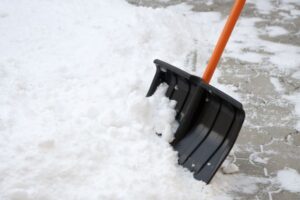Monthly Archives: November 2016
It’s time for a low salt diet
When it rains, pollution on streets, parking lots and lawns is washed into storm drains, then directly to our drinking water supplies and the lakes our children play in each summer. Fertilizer, oil, pesticides, detergents, pet waste, and road salt all makes its way from your property to your water.
With winter approaching, now is the time to consider how to balance personal safety and environmental health by looking at ways to reduce the use of salt on your property while preventing slips and falls on the ice.
Over the past several years, our local municipalities have been taking steps to reduce the amount of road salt that reaches our lakes and rivers. With improved salt storage and application practices, they have been working to reduce the total amount of road salt used each winter while maintaining safe winter driving conditions.

However, an estimated five to ten percent of road salt in the environment comes from parking lots and private properties, many of which are located in close proximity to surface water in Muskoka. While there are regulations and best management practices in place for public road maintenance, little thought is given to the use of road salt on private property.
You can reduce salt pollution
Keeping ice and snow off your driveway and walkway is important for safety. The following tips can help you do this while reducing your impact on your watershed.
- Buy early – make sure you buy your deicing product well before a big storm hits. Otherwise, you could be looking at empty shelves and have few, if any, environmental choices to make at the store.
- Check the label – each main ingredient of common deicing products have various pros and cons. Check the package label closely to see what you are buying.
Calcium Magnesium Acetate (CMA) – Effective temperature -6 °C
(+) less toxic
Calcium Chloride (CaCl) – Effective temperature -32 °C
(+) can use lower doses (+) no cyanide (-) chloride impact
Urea – Effective temperature -7 °C
(+) Less corrosion (-) adds needless nutrients
Sand – No melting effect
(-) Accumulates in streets and lakes
Sodium Chloride (NaCl) (rock salt) – Effective temperature -9 °C
(-) Contains cyanide (-) Chloride impact
- Avoid using kitty litter and ashes – although these products are environmentally friendly, they aren’t very effective. While they provide some traction, they do not melt snow and ice. They also tend to get gooey and messy when it warms up, which often tracks on to the floors of your home. If traction is what you want, then stick with coarse sand, which is much cheaper and easier to sweep up.
- Shovel early and often – Deicers work best when there is only a thin layer of snow or ice that must be melted. Get out the snow shovel and move as much snow as you can during the storm. A flat hoe can also help to scrape ice off the surface before any deicers are applied.
- Know your salt risk zone – over fifty percent of woody plant species are sensitive to sodium chloride, including most trees found in Canadian forests, like maple, white pine, hemlock, ash, dogwood, spirea, and fir. Check out the plants that grow within five or ten feet of any area you might salt for salt-sensitive species. If you have salt-sensitive trees, shrubs or grasses in these zones, you should avoid any deicing product that contains chlorides. You may want to use CMA as a safer alternative, or stick with sand for traction.
- Avoid products that contain urea – even though it is seen as a safer product than more common deicing products because it does not contain any chlorides and will help fertilize your lawn when it washes off. In reality, urea-based deicing products are a poor choice; urea is fairly expensive; performs poorly when temperatures drop below -7 °C; and contains much more fertilizer than your lawn would ever need. Furthermore, because urea is applied to driveways and walkways, very little of the urea will actually get to your lawn and instead will wash into the closest waterbody.
- Apply salt early, but sparingly – and only after you have scraped off as much snow and ice as possible. Using more salt than recommended won’t speed up the melting process but will harm the environment. If you have a choice, pick calcium chloride over sodium chloride. Calcium chloride works at much lower temperatures and is applied at a much lower rate.
Research has shown that as the amount of impermeable surfaces in a watershed increases, so does the chloride concentration. As development progresses in Muskoka, the amount of impermeable surfaces will continue to increase. One way we can ensure that this development doesn’t impact our watersheds is to manage and use deicing agents more effectively.
